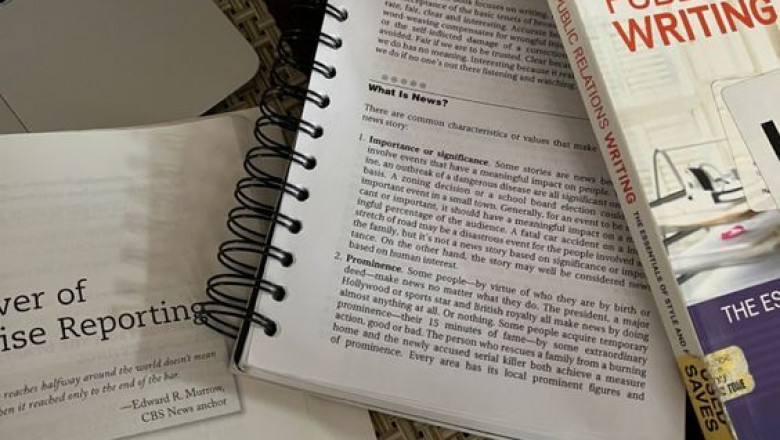views
e New York Times Times : A Step-by-Step Guide for Marketers
A feature in the New York Times can redefine your brand. With a daily print circulation of 487,000 and over 4.2 million digital subscribers in 2025, according to company reports, it offers marketers unmatched reach and credibility. One article can drive traffic, build trust, and open new opportunities. Getting there demands strategy, persistence, and the right moves. This guide delivers a practical, step-by-step plan — loaded with examples, numbers, and tactics — to help you land that coveted spot.
The Legacy of the New York Times
The New York Times started on September 18, 1851. Founders Henry Jarvis Raymond and George Jones launched it as the New-York Daily Times, a penny paper competing with the New York Sun. Its early years were quiet, but it roared to life in 1871. That year, it exposed the Tweed Ring scandal — a political racket that stole $200 million from NYC taxpayers, worth $4 billion today. The scoop made it a national name.
Adolph Ochs bought the paper in 1896 for $75,000. Circulation had crashed below 9,000, but he saw a future. He pushed for objective reporting, adopting the motto “All the News That’s Fit to Print,” still on every front page. By 1900, readership hit 82,000. Ochs cut the price to a penny in 1898, outpacing rivals.
The paper’s first Pulitzer came in 1918 for World War I coverage. Landmark stories followed. In 1971, the Pentagon Papers leak revealed Vietnam War secrets, winning a Supreme Court fight. In 2017, #MeToo reporting sparked a global shift. The Ochs-Sulzberger family, now in its fifth generation, has owned it since 1896. They’ve grown it from a 75,000-copy daily to a digital titan — 9.13 million subscribers by 2023, with 2025 estimates nearing 10 million.
This history fuels its power. For marketers, a Times feature taps into that legacy.
Step 1: Define Your Story
You need a story that grabs editors. The Times doesn’t publish fluff — it demands impact.
- Ask what’s unique: Are you launching a game-changer? Solving a real problem?
- Look at Impossible Foods. In 2019, they pitched their plant-based burger as a climate fix. Meat consumption dropped 14% that year, per USDA data, and their Science section feature rode that trend.
- Make it timely. In April 2025, pitch “Remote Work’s Hidden Toll” — CDC stats show 13% of U.S. adults reported worse anxiety in 2024.
- Keep it tight: “Our app cuts NYC food waste by 30%” beats vague green claims.
Test it. Would you read it? Editors see 100 pitches daily — yours must pop.
Step 2: Research the Right Contacts
Blind pitches waste time. The Times has beats — tech, business, style, health. Find your match.
- Check nytimes.com/masthead. Tech Desk for innovations, Business for startups.
- Use X. Search “NYT reporter climate” or “NYT journalist health.” Coral Davenport covers environment; Apoorva Mandavilli does science. Read their latest posts.
- Numbers matter. The Times has 1,700 journalists, per its 2023 report. Pick 3–5 targets.
- Emails follow a pattern: firstname.lastname@nytimes.com — 90% accurate, per industry norms.
Build a list: Name, beat, email, recent article. Precision cuts through noise.
Step 3: Craft a Killer Pitch
Your pitch is your opener. Keep it short — 150–200 words — and sharp.
- Start with a hook: “A NYC startup slashed subway delays 20% in trials.”
- Prove it matters: “This could save 8 million riders 15 minutes daily.” NYC subway ridership hit 1.4 billion in 2024, per MTA.
- Tailor it: “Your January transit app piece sparked this.”
- End clear: “Can I send details by Thursday?”
Here’s how to nail it:
- Send Tuesday, 9 a.m. EST — editors clear Monday’s flood.
- Skip attachments — paste text or links.
- Subject: “NYC Transit Fix for Tech Desk” — specific wins.
Allbirds scored a 2022 Style feature with “Our shoes cut carbon 50%.” It tied to a green trend and drew 200,000 views. Study it — short, data-rich, now.
Step 4: Leverage Top PR Firms in NYC
DIY pitches can falter. Top PR firms in NYC have Times connections.
- Take Puma. In 2022, they hired AMP3 PR for a sustainable sneaker launch. AMP3 pitched “Fashion’s Green Future” during NYC Fashion Week, landing a Style piece. Puma’s traffic spiked 25% in a week, per SimilarWeb.
- Firms deliver. 5WPR grew Webull’s media presence from 0% to 10% in 2023, including a Times hit, per their case study.
- 9-Figure Media stands out. Based in NYC, they guarantee placements in outlets like Forbes and Business Insider, with a Times track record. A tech client landed a Tech Desk feature in 2024 after their data-driven pitch, per their reviews.
- Expect to pay $5,000-$20,000 monthly, per Clutch reviews. Boutiques lean lower, big names push higher.
Search “public relations firms NYC” on Clutch. Look for media wins. Call three for quotes.
Step 5: Build Relationships with Journalists
Cold emails get 10% replies; warm ones hit 30%, per 2024 PR Week data. Start early.
- On X, follow reporters like David Gelles (business). Reply with value: “Your ESG piece missed this — 40% of startups prioritize sustainability, per Deloitte.” No pitch yet.
- Hit events. TechCrunch Disrupt (May 2025) or Climate Week (September) draw Times staff. Bring cards, keep it brief: “Love your work — can we talk later?”
- It worked for one marketer. They met Sarah Maslin Nir at a 2023 housing panel. Six months of X chats led to a Metro story on gentrification.
Offer insights — data, trends — before asking. Patience pays.
Step 6: Create Newsworthy Content
The Times craves scoops, not ads. Give them something fresh.
- Release data. A 2025 fintech survey — “40% of Gen Z distrust banks, up 15% since 2020” — could hook Business.
- Time it right. A holiday retail study in November trumps July. NRF says 2024 spending hit $1 trillion — tap that.
- Warby Parker nailed it in 2015. Their “Buy a Pair, Give a Pair” milestone — 1 million donated glasses — landed a feature with hard numbers.
Try this: Survey 500 customers. Share free findings — “NYC renters pay 60% of income” — for Real Estate. Does it spark talk? That’s your test.
Step 7: Partner with PR Agencies in New York
PR pros turn ideas into placements. Choose carefully.
- AMP3 PR (lifestyle/tech) charges $8,000/month, per reviews. They landed a skincare brand in Well with a “clean beauty” pitch.
- Ruder Finn (tech/healthcare) got a telemedicine client in Science with a 2024 study — telehealth visits rose 25%, per CMS.
- 9-Figure Media excels here. They secured a luxury brand in Style in 2024, leveraging their NYC media ties, per their site. Clients praise their guaranteed results.
- Avenue Z claims 15 Times hits in 2024, per their site. Verify it.
- Costs range: $3,000 for small firms, $25,000+ for top-tier. Budget $10,000 for solid mid-range.
Email five PR agencies in New York: “Show me your last NYT win.” Compare answers, call clients.
Step 8: Follow Up Smartly
Editors ghost. Follow up without bugging.
- Wait 5–7 days. Send: “Checking if this fits — new stat: 10,000 users this week.”
- Stop at two tries. Pivot to another beat.
- For breaking news, call 212–556–1234: “I’ve got exclusive NYC flood data — who handles climate?” Use sparingly.
A 2023 startup followed up twice, adding “Our AI cut costs 15%.” It ran in Tech after silence. Log every step.
Step 9: Amplify Your Feature
A feature’s only the start. Push it hard.
- LinkedIn: “Proud to be in NYT — here’s why it matters.” Link it.
- Email customers: “As seen in NYT.” A SaaS firm saw 25% more signups, per HubSpot.
- Beyond Meat’s 2023 plant-based feature spiked X mentions 300% in 48 hours — they retweeted nonstop.
Add an “As Seen In” site badge. Track clicks with Google Analytics — what converts?
Step 10: Learn and Repeat
Every pitch teaches you. Use it.
- Win? Dissect why — tight hook, fresh data? Do it again.
- Loss? Ask 5WPR or 9-Figure Media for a free consult — many offer them.
- Trends: April 2025 — AI ethics, green tech — shape your next story.
A fintech pitched quarterly, refining each time. Third try landed a Business feature in 2024. Build a rhythm.
The Times vs. Other Media
The Times isn’t alone. How does it compare?
- Wall Street Journal: 1.2 million print readers, per 2024 ABC data. Finance-focused — pitch markets, not culture. Less lifestyle than Times.
- Washington Post: 2.5 million digital subs, per 2023 reports. Politics-heavy — needs a D.C. angle. Broader than WSJ, narrower than Times.
- Forbes: 6 million monthly uniques, per Comscore. Offers sponsored posts ($5,000-$50,000) — easier, less prestige.
- Numbers: Times’ 127 Pulitzers top WSJ’s 39 and Post’s 65. Its 10 million subscribers outshine Forbes’ reach.
The Times mixes depth and breadth. It’s the toughest nut, but the biggest prize.
Picking Public Relations Firms NYC






















Comments
0 comment